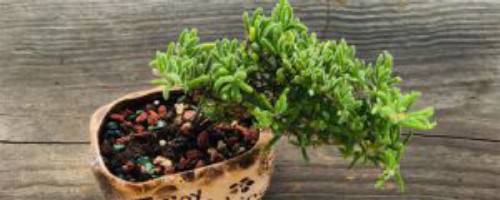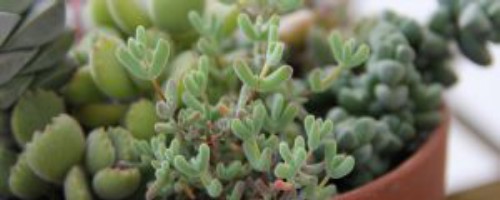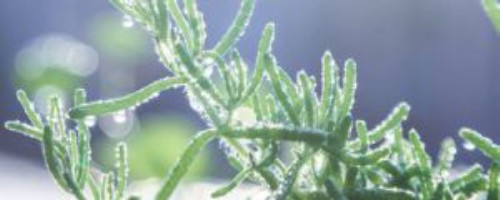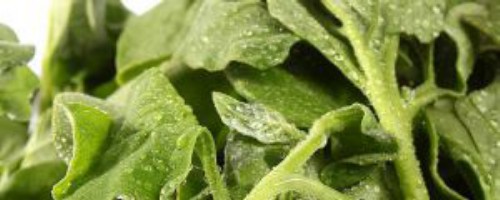Dicrocaulon ramulosum is a Dicrocaulon ramulosum family plant, in fact, many people call it spinach, it is a relatively edible value, the stems and leaves can be eaten. Succulent Dicrocaulon ramulosum belongs to the Dicrocaulon ramulosum family (Aizoaceae), but the English scientific name specific to a particular variety of succulent Dicrocaulon ramulosum may vary from species to species.

Causes of Dicrocaulon ramulosum yellow leaves and treatment methods
Temperature is too low:
Reason: The growing environment of Dicrocaulon ramulosum should be warm and suitable, and the temperature should be controlled at about 15-25 degrees Celsius. Too low a temperature can cause frost damage to plants and turn their leaves yellow.
Treatment: When the temperature is too low in winter, it is necessary to control the temperature, you can transfer the plant indoors, and ensure that the temperature is kept above 10 degrees to avoid frostbite.
Watering too much:
Reason: The Dicrocaulon ramulosum should be watered in moderation. Overwatering can cause water to accumulate in the soil, the roots to rot and the leaves to turn yellow.
Treatment: When watering too much, should be timely drainage. If the situation is serious, it is necessary to remove the pot, cut off the festering roots, and then replace the fresh soil to replant. In the usual maintenance, pay attention to watering when the branches and leaves are shriveled.
Lack of light:
Why: Dicrocaulon ramulosum requires plenty of sunlight to grow healthily. Lack of light causes the leaves of plants to turn yellow.
What to do: Make sure your plants get plenty of sunlight. In winter, plants can be moved indoors to the sun; In summer, be careful to avoid direct light.
Improper fertilization:
Reason: Dicrocaulon ramulosum needs proper fertilizer to ensure nutrient supply during its growing period. Insufficient nutrients or excessive fertilization can lead to yellow leaves.
Treatment method: When the nutrient is insufficient, the diluted leaf fertilizer should be added in time. If the fertilizer is too much, use a lot of water to dilute the fertilizer, or dig out the roots of the plant to rinse and replant.

Breeding methods and precautions of Dicrocaulon ramulosum

Breeding methods
Soil selection:
Should choose the texture of loose breathable, good water retention effect of soil.
The recommended soil mix is a 4:4:2:1:1 mixture of nutrient soil, coal ash, sand, plant ash, and perlite, or a 4:6:1 mixture of nutrient soil, vermiculite, and perlite.
Sowing and Propagation:
Before sowing, spread an even layer of sand on the surface of the soil, and then spread the seeds after wetting.
The planting position should be dense, and no soil should be covered after sowing.
It can also be propagated by cutting, inserting healthy branches into the sand bed, maintaining humidity, rooting for about 15-20 days.
Watering and humidity:
Dicrocaulon ramulosum should be watered by dipping, slowly wetting the soil through small holes in the bottom of the pot.
In summer, you can put a water tray at the bottom of the flower pot to keep the bottom moist; Keep the soil slightly moist in winter.
Sun and Temperature:
Dicrocaulon ramulosum requires full sunlight, but not exposure.
Shade in summer, winter should be placed in a corner where you can see the sun.
Fertilization:
Fertilizer can be applied 1-2 months after germination.
Fertilizer should be diluted after use, still use dip fertilization.
Note:
Seedling Management:
Manage seedlings carefully and avoid excessive moisture to prevent rot.
If the seedling roots reach the soil surface, gently bury them into the soil.
Flower pot selection:
The sowing bowl is best to choose a tile pot with good permeability, rather than a ceramic pot.
The thickness of the soil in the pot before sowing is controlled at 8-10 cm.
Pest Control:
Dicrocaulon ramulosum Although stress-resistant, care is still needed to prevent pests and diseases.
Potting and transplanting:
When the seedlings grow up, in order to absorb enough nutrients, they should be placed in the pot.
The seedlings should be watered after a week.

Dicrocaulon ramulosum is also known as New Zealand spinach, ocean spinach, and summer spinach.
Dicrocaulon ramulosum prefers a warm growing climate with strong adaptability. It does not require much light and can tolerate shade. When breeding Dicrocaulon ramulosum, it should be given a humid environment, the soil is generally required to be loose and fertile, sandy soil can be farmed. Usually pay attention to fertilization, its demand for nitrogen fertilizer and potash fertilizer is relatively large.
Dicrocaulon ramulosum is widely distributed in the United States, Australia and China.
Dicrocaulon ramulosum is actually very edible. It tastes a bit like spinach, making it a very tasty seaside vegetable.